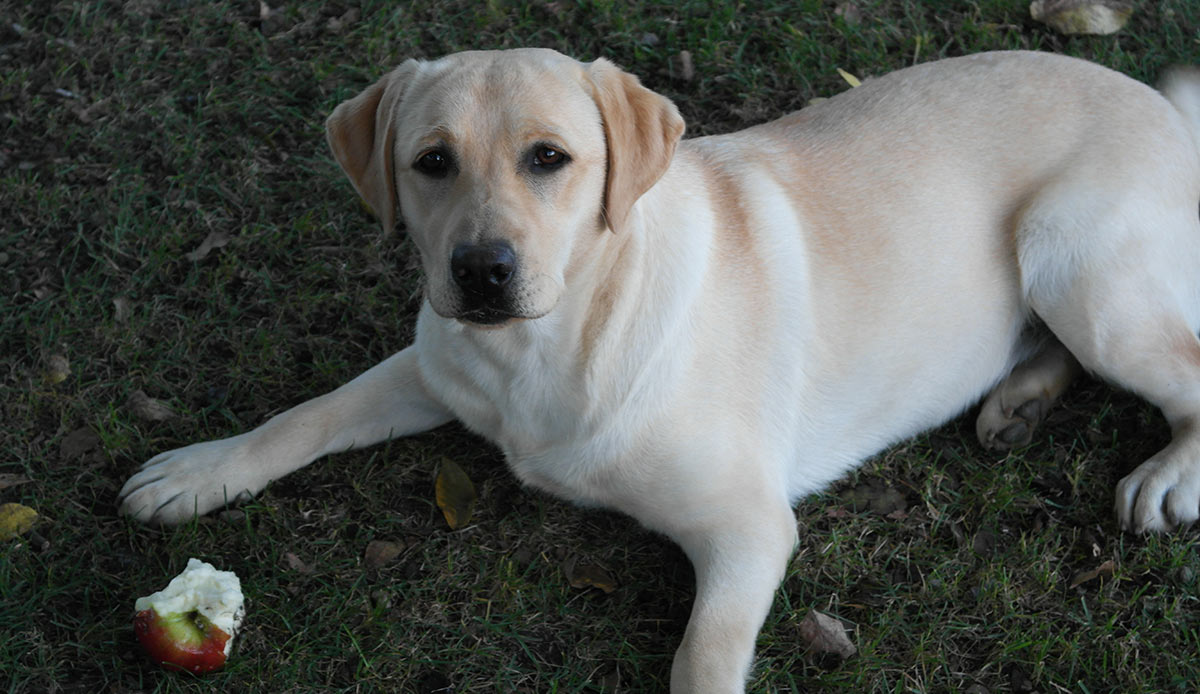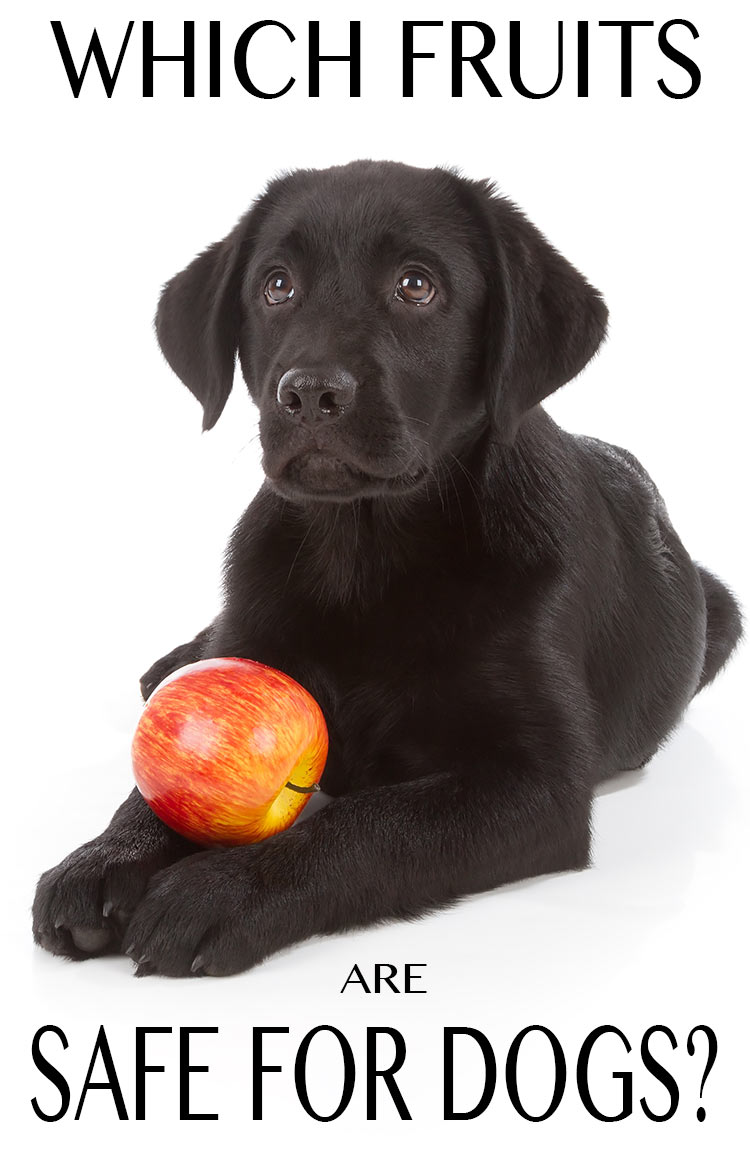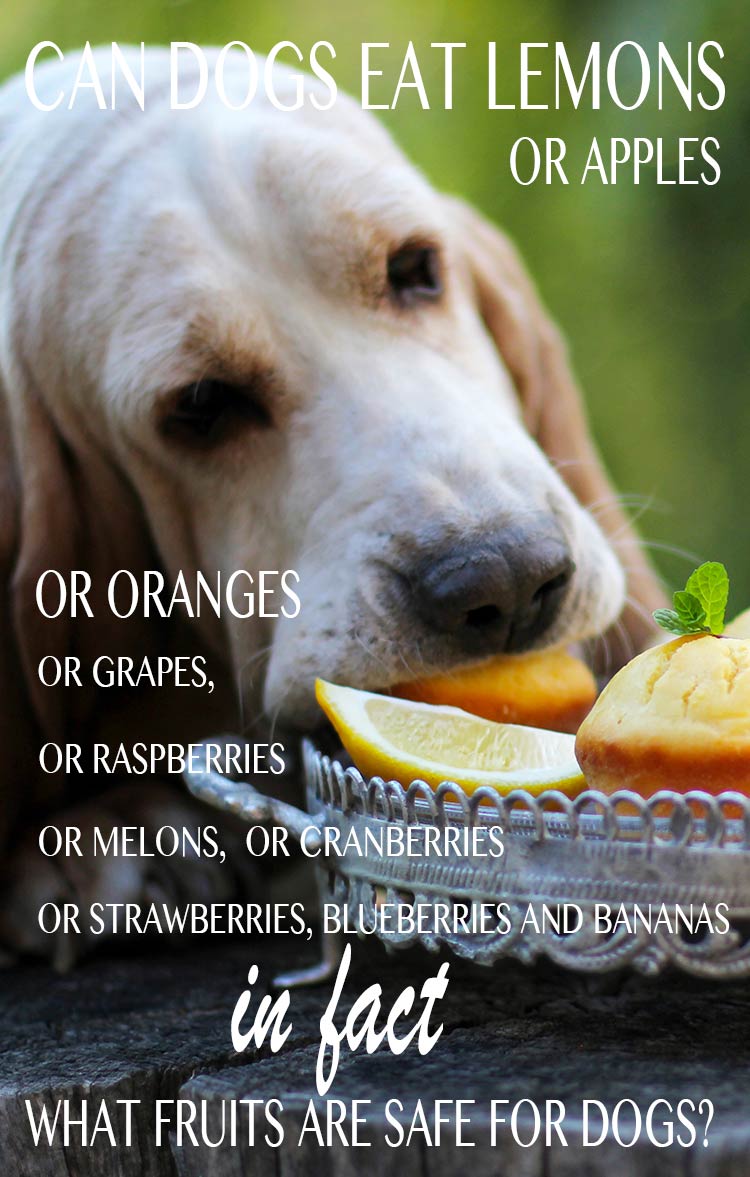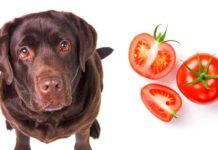When I was a kid, we always gave our apple cores to the dog. He loved them. But can dogs eat apples without any ill effects or or were we taking a risk? Similarly, if your dog likes fruit you may be wondering if you should be feeding him apples, grapes, berries or any of the other common fruits we find in our homes.
I’ve done some updated research and t I’m going to outline what fruits dogs can eat without harm, and identify which fruits dogs should not eat. We’ll also discover which fruits are actually good for dogs, and therefore could be a healthy addition to their diet.
Can dogs eat apples?
Apples contain a number of vitamins including vitamin C. They also contain some dietary fibre, and some minerals, including phosphorus and calcium Most experts agree that the flesh of the apple is safe for dogs to eat. And many recommend giving dogs apple slices as a healthy snack. You can also freeze apple slices or pulp to give dogs a refreshing treat in hot weather or use apples in recipes for baked dog treats. We’ll look at some of those in a moment
Can dogs eat apple cores?
Can dogs eat apples whole? Or the cores specifically? In retrospect the apple cores I used to give to our Golden Retriever when I was a child were probably not such a good idea.

Can dogs eat apples – skin and peel?
It won’t harm your dog to eat apple skin or peel. However, the skin can irritate the stomach of some dogs and trigger vomiting. So if your dog is relaxing on your favorite carpet, you might want to bear that in mind!
It is also worth remembering that apples contain a lot of natural sugars, which dogs do not need to eat at all. These can harm their teeth if consumed in excess. So the question is not just can dogs eat apples, but should they! Moderation, when giving this sweet treat, is definitely a good idea.
Can dogs eat grapes?
The second fruit on our list is a very different story. The answer to, ‘can dogs eat grapes’ is a firm “NO.” Your dog should not be given grapes, grape juice, or grape byproducts in any shape or form.
Why shouldn’t dogs eat grapes?
Eating grapes can cause kidney failure in dogs. One study suggests as little as 19.6 grams of grape, per kilogram of dog could cause this. This is made even more complicated because, not all dogs will be visibly affected.
The mechanism by which grapes poison dogs is still being researched. Still it is not known why some dogs may be fatally poisoned by only a small quantity of grapes, while others can eat quite a few without any ill effects. This is a common occurrence when we discuss foods that are potentially toxic to dogs. You will often find that some persons say, “My dog eats those all the time and he’s fine!” Just like my Golden Retriever who used to eat apple cores.

Remember, the toxicity of grapes in dogs is well documented, and they should not be a part of your dog’s diet Your dog may not appear to have been harmed by eating grapes on one occasion but you are taking a chance with his health every time you let him do it.
Can dogs eat raisins?
Raisins are a type of dehydrated grape and the same rules apply. Raisins can be very attractive to dogs because the sugar in them is so concentrated but they are equally as dangerous if not more so. Special precautions should be taken when giving your dog one of the many baked products made for humans that may contain raisins. Ensure you are certain of the ingredients in baked products before you share them with your dog.
What to do if your dog eats grapes or raisins
Dogs affected by grapes may vomit and become very thirsty. If your dog accidentally ingests grapes, telephone your vet straight away and ask for advice. If your dog has not already begun vomiting, your vet may want you to induce vomiting before the dog is brought into the office
Do not induce vomiting without first checking with a veterinary health professional.
Can dogs eat oranges?
Oranges can be consumed by most dogs in small quantities without any ill effects. Large amounts may give your dog diarrhea. Again, these fruits are high in sugar so moderation is key.
Can dogs eat lemons
Lemons are citrus fruits like oranges and the same rules apply. A small amount is unlikely to cause a problem, but too much and you’ll have an upset tummy on your hands.
 Can dogs eat peaches and plums?
Can dogs eat peaches and plums?
The flesh of fruit with pits or stones in the center is another tasty favorite of some dogs. Many wild carnivores love these fleshy fruits especially when they are over-ripe. However, while these fruits are a rich source of vitamins, you should never give your dog the whole fruit or the pits of plums or peaches. Not only are they toxic, they could choke your dog or cause an intestinal blockage.
Can dogs eat bananas?
Bananas are deliciously sweet and many animals love them. Dogs are no exception. Dogs can eat bananas without issue, but remember that the sweet taste is a reminder of how sugary they are.
Can dogs have blueberries?
Blueberries are safe for dogs to eat either fresh or frozen. They are high in antioxidants which help to fight free radicals. Free radicals are substances that cause damage to cells and may be implicated in the development of cancer. This means that blueberries are often recommended as a treat for dogs of all breeds.
Blueberries should also be considered for very active dogs or members of the working class breeds of dogs . This is because the oxidative muscle damage caused by these free radicals is most intense during high activity and exercise.
Can dogs eat cranberries?
Cranberries have long been associated with bladder health in humans. It’s possible that eating cranberries helps to make the bladder wall less sticky, so that it is harder for certain bacteria (E Coli for example) to get a grip and start growing there. This may help reduce the occurrence of urinary tract infections.
While swallowing the occasional cranberry won’t hurt your dog, it is also possible that regular intake of cranberries could lead to bladder stones. With plenty of fruity alternatives, giving cranberries a miss is probably a good idea
Can dogs eat pears?
Pears are another great treat for fruit-loving pooch! They are chock full of Vitamins C and A, and are a healthy source of dietary fiber. As with the question “can dogs eat apples” however, you should not give your dog the seeds or the core. Pear seeds are toxic and can cause harm in large quantities, and the core does pose a choking hazard.
Can dogs eat tomatoes?
Yes, tomatoes are actually fruit, and they are safe for dog consumption–when ripe. The stems, leaves and green fruit of a tomato plant contain high amounts of a substance called tomatine that could be harmful in large quantities. This concentration is far lower in ripe fruits, and as such can be fed to your dog in moderate quantities. But remember tomatoes do have a high acid content and should not be fed to dogs with sensitive stomachs or a history of digestive concerns.
When is fruit good for dogs?
If you are struggling to get a thin, elderly dog to eat then supplementing with their favorite fruit may be a good incentive. Also, if you are trying to give a particularly savvy pup medication, hiding it in fruit may be a good trick to keep in your arsenal. In either case just be sure not to give the dog so much that it upsets his stomach.
Fruit can also be a good way of getting nutrients into a dog on special low fat diet. Keep in mind though, that while we tend to think of low-fat foods like apples as being healthy for most healthy dogs, certain foods that are high in sugar are not a necessary or even valuable part of their diet. And can contribute to obesity.
If you want to put weight on a thin dog, feeding his usual food more frequently will usually enable you to increase overall quantities without upsetting his tum with added dietary variety. And for raw fed dogs, fat is an ideal source of extra calories and the source that your dog’s digestion is best designed to process.
Remember when feeding your dog fruit:
- Wash all fruit before feeding it to your dog
- Remove all flesh from cores, pits and stones
- Sharing prepared foods with your pet should be done at a minimum however if you choose to do so ensure there are no hidden, ingredients that may be toxic to your pup
- Even if a fruit is deemed safe for your dog, test with a small piece and monitor your dog for any sensitivities
- Peel waxy fruits as the skin may cause stomach irritation
- Never give your dog whole fruit!
Summary – What fruits can dogs eat?
I hope you’ve found “Can Dogs Eat Apples?” interesting. I’ve certainly enjoyed researching and learning more about this topic. Fruit is not an essential part of any dogs diet. And the answer to “Can dogs eat apples?” isn’t a straightforward yes or no. In moderation it is fine to give your dog the occasional slice of apple, pear, peach, ripe tomatoes or plum.
You can also use the flesh of these fruits when baking your favorite home cooked dog biscuits. You can give your dog a piece of banana or a slice of orange or lemon if he enjoys them. Certain fruits, especially berries, may even present health benefits and you should discuss with your vet supplementing your dog’s diet with these antioxidant rich options.
Take special precautions based on the type of fruit, the health of your dog and your dog’s particular sensitivities when deciding to feed them fruit. And finally, before you leap for the fruit bowl, remember that fruit is high in sugar and should only be fed as an occasional treat, not in large quantities.
How about your dog?
Does your dog have a favorite fruity snack? Tell us about him in the comments below!
“Can Dogs Eat Apples and Other Fruit” has been fully revised and updated for 2019.
Readers Also Liked
- How to Make a Dog Vomit
References
- Total antioxidant power in sled dogs supplemented with blueberries and the comparison of blood parameters associated with exercise. Kriya L.DunlapArleigh J.ReynoldsLawrence K.Duffy (2006)
- Acute Renal Failure in Dogs After the Ingestion of Grapes or Raisins: A Retrospective Evaluation of 43 Dogs (1992–2002) Paul A. Eubig, Melinda S. Brady, Sharon M. Gwaltney‐Brant, Safdar A. Khan, Elisa M. Mazzaferro, Carla M.K. Morrow (2008)
- Canine renal failure syndrome in three dogs Won-Il Jeong, Sun Hee Do, Da-Hee Jeong, Jae-Yong Chung, Hai-Jie Yang, Dong-Wei Yuan, Il-Hwa Hong, Jin-Kyu Park, Moon-Jung Goo and Kyu-Shik Jeong (2006)
- Effects of cranberry extract on prevention of urinary tract infection in dogs and on adhesion of Escherichia coli to Madin-Darby canine kidney cells Hsin-I Chou DVM, MSC; Kuan-Sheng Chen DVM, PhD; Hsien-Chi Wang DVM, PhD; Wei-Ming Lee DVM, PhD
- Grapes, Raisins, and Sultanas, and Other Foods Toxic to Dogs, Alexander Campbell (2013)
The Labrador Site Founder
Pippa Mattinson is the best selling author of The Happy Puppy Handbook, the Labrador Handbook, Choosing The Perfect Puppy, and Total Recall.
She is also the founder of the Gundog Trust and the Dogsnet Online Training Program
Pippa's online training courses were launched in 2019 and you can find the latest course dates on the Dogsnet website


 Can dogs eat peaches and plums?
Can dogs eat peaches and plums?

















My 13month black lab Chuck has never had any fruit or veg. Just his nuts and meat from Sunday dinner as a treat. He seems to have a very sensitive stomach. Would it be ok to introduce some fruit and bed to him? Thanks in advance.
Really interesting read thank you. My girly ten year old black lab Tara has grated apple in with her food as she is on a raw food diet and just helps with bowel movements. She also loves frozen peas.
Our dogs (Lab and Beagle) love love love carrots, apples, pears, broccoli stems, bananas and cherry tomatoes ! They come running when they here the veg prep being done. Peanuts and peanut butter – I have a jar of smooth just for them in their Kongs, along with squeezy cheese – this is a rare treat though.
What about Pears? Our Beagle eats them from the tree in our backyard! He’ll spend a whole day munching away on one.
Hi I my nearly 2-year-old Black Lab, Sierra, has an obsession for ice cubes. Recently, while finding an ice cube for her, I noticed my bag of frozen peaches and I wondered:
Are frozen peaches safe for a young lab (or any lab)? I think she would like them and it would be a nice substitute for feeding her all my ice cubes!
Thanks in advance!
Great article again Pippa..thank you!
Whilst discussing which fruits our labs can eat, how about veggies? Captain, our 2 yr.old yellow lab, loves carrots and whole leaf romaine lettuce as well as fruits! Virtually impossible to make a nightly salad without his loving presence at my side. This is the only human food he gets,except the occasional lick of peanut butter. Thank you again!
Veggies coming up soon Jeff 🙂
I have a question my dog likes tomatoes is this bad? She looks at me eating them out of the garden. When she is by herself she has a tendency to help herself. Thanks Doug
We switched our girls to carrots a few years ago because they were always front and centre when the fridge was opened, so instead of feeling mean (you know their little faces) and giving them nothing, or giving them something they shouldn’t really have, we now give them a piece of carrot each. All fruit is their favourite (NO GRAPES) just like everything with Labs – little lab doesn’t like whole cherry tomatoes, she’s grossed out when they pop in her mouth lol
Our nine year old lab, Ollie has a cut up apple each day with the pips taken out, when we have ours at lunch times, he also likes a couple of pieces of satsumas or clementines each day. He also loves marmite! When I steam our vegetables for our meal I always cook extra carrots or the broccoli stalks for Ollie and he has a few pieces mixed with his meals.
We adopted Pepper last spring and think she is 7 1/2-8 yrs (but doesn’t know it!). I’ve never owned a lab so this has been an eventful and fun learning curve. She’s a love!
We have two fuji apple trees and Pepper sometimes shows up in the house with one. She knocks it around and then chews on it for a while, so I find half-eaten ones lying around the house and yard. There are opossums, raccoons and other creatures in the area who also like the apples, and when I find their teeth marks in a partially eaten one, I immediately throw it out because I’m concerned about disease.
Didn’t know that the skin could be bad for them, so will offer Pepper skinless slices from now on!
Thank you — love reading and learning from you!
Glad you are enjoying the site Ellen 🙂
Ha! My 10 month old female lab will eat pretty much anything (besides her kibble, where she’s a pretty fussy eater!)…
Some of her “human food” favorites are bananas (which I slice and then freeze into bite-size pieces), apple, berries, and pumpkin!
My 13-month old yellow lab, Archie, has several food sensitivities. The only meat proteins he can eat are beef and rabbit and he does not get any grains and we limit the carbs. He is also on herbal supplements, and under the care of a holistic vet (traditional veterinary medicine did not help, and in fact, hurt him more.) He eats a commercially produced raw diet (Raw Bistro Beef Entree), but finding treats he can eat is difficult, at best. I make much of his treats as He can’t have any kind of flour, other than coconut flour, which is not great to bake with. He LOVES ice cubes. So, in an effort to diversify his treat choices, I make an organic fruit smoothie comprised of natural applesauce, blueberries, bananas, and pears. Not only do we both enjoy a couple spoonfuls of smoothie before freezing, he loves the frozen fruit treats that I make in dog none and paw shapes. He gets a couple a day and just loves them! I will also give him a bite of banana or a couple of blueberries if I am eating them, and he enjoys banana chips from time to time. I feel much better giving him these natural treats than the majority of commercially produced crap on the market.
My lab @ 10 months expects two watermelon slice rinds in the morning. After her exercise, he gets some peanut butter on one of her bones. I am not sure which item it is but she is starting to gain weight. I am glad to hear about the sugar and will cut out the watermelon. I think she will eat anything so will find something with less sugar as a substitute.
Thanks always for the info you send.
Sue Peters
Is there a natural way to treat ‘fat pockets’ on my lab? Riley has two types, one solid and a couple that are soft. The vet says they are not dangerous and can only be removed by surgery. He is 9 and I would prefer to avoid surgery.
Another great article Pippa. I have a 5 year old Lab and I work him each morning in a field where there are 2 crab apple trees. My Lab loves these crab apples that have fallen during the autumn from the tree. He especially seems to like the ones that are slightly rotten. If I let him, he would eat as many as he could, but I try to restrict him to two or three per day. I have found the apples actually seem to have helped his digestive system. Like others, I do wonder if various types of fruits affect different breeds in different ways and so with my Lab, I try to use common sense, so I’m wary of what he eats and figure I’ll try him with small portions and see what reaction there is.
My last dog was Casper, a pear-addicted Weimaraner. When our pear tree started to fruit he would leap up to pull off and eat whatever pears he could reach.
Then he would lay down under the tree and wait for the fruit to fall off!
All of the Labs we have had loved raspberries, apple skins and especially bananas.
Sally, my three-year old lab, loves to hang out with me lakeside during the summer. We have a tradition, enforced by Sally, that we “share” a fruit bowl suited to summer sun: usually cantaloupe, watermelon, and honeydew. In the winter, the sound of a crunching carrot results in Sally waiting attentively for hers.
I wonder if different breeds have varying degrees of tolerance to some fruits such as grapes. I have had several Labradors over my lifetime and none have reacted badly to grapes. When you are surrounded by vineyards, it’s often quite easy for the dogs to eat quite large quantities, whether they be table grapes, wine grapes or dried fruit. The only trouble we had with one dog was needing to give her assistance occasionally to pass dried grape bunch stems. ( She would stand there with a “help me please” look on her face and we would have to help pull it out – usually using a couple sticks, as if using chopsticks !! )
One Lab had an adverse reaction to eating avocados and would act as though she was under the influence of drugs and not know quite what was going on. Again, this was after eating quite a few fruit.
I give our lab a winter carrot each day instead of a denta stick! He likes them very much! It’s not fruit but a veggie….He like apples, hazelnuts out of the neighbors garden still in the shell, lemons, blueberries, babanas, mandarins, strawberries etc etc….
Thank you for your great articles and information on re-training. In my case – and it is a 4-year old female Border Collie – she had very little training at all in her previous life: she was raised by two small boys. I’m unsure the adults took any part at all. I’ve had her four months and she’s very affectionate and generally has learned what I need her to – except “come” when she is running free. If she’s in the dog park, she comes straight away – same in the house. NOW, I am 82 and lack the stamina to be outside with her a lot, nor do I have a place for her to run free very often. That’s definitely an un-train or re-train and I’m hoping your great lessons and the whistle will allow her more exercise fun w/o wearing me out. I’ve had collies and border collies, but my health took a bad turn for the worst shortly after I got her … I might have chosen a less active dog had I known I wouldn’t be able to give her the time. I really appreciate your agreeing with me that punishment, especially with a border collie, is one of the worst things you can do. Soarsha is smart – and I believe with your help – and your whistle – I can arrive at and maintain a healthy and active life for my dog.
I truly do thank you – she is my sole companion and I hate to place restrictions on her because of my not being able to train her to have a joyful life with me, even if a bit more limited than we both might like.
The comment, above, is pretty much all I have to say
Thank you for your great articles and information on re-training. In my case – and it is a 4-year old female Border Collie – she had very little training at all in her previous life: she was raised by two small boys. I’m unsure the adults took any part at all. I’ve had her four months and she’s very affectionate and generally has learned what I need her to – except “come” when she is running free. If she’s in the dog park, she comes straight away – same in the house. NOW, I am 82 and lack the stamina to be outside with her a lot, nor do I have a place for her to run free very often. That’s definitely an un-train or re-train and I’m hoping your great lessons and the whistle will allow her more exercise fun w/o wearing me out. I’ve had collies and border collies, but my health took a bad turn for the worst shortly after I got her … I might have chosen a less active dog had I known I wouldn’t be able to give her the time. I really appreciate your agreeing with me that punishment, especially with a border collie, is one of the worst things you can do. Soarsha is smart – and I believe with your help – and your whistle – I can arrive at and maintain a healthy and active life for my dog.
I truly do thank you – she is my sole companion and I hate to place restrictions on her because of my not being able to train her to have a joyful life with me, even if a bit more limited than we both might like.
Shirley Ayn Linder